The Mac Pro Review (Late 2013)
by Anand Lal Shimpi on December 31, 2013 3:18 PM ESTGPU Choices
The modern Apple is a big fan of GPU power. This is true regardless of whether we’re talking about phones, tablets, notebooks or, more recently, desktops. The new Mac Pro is no exception as it is the first Mac in Apple history to ship with two GPUs by default.
AMD won the contract this time around. The new Mac Pro comes outfitted with a pair of identical Pitcairn, Tahiti LE or Tahiti XT derived FirePro branded GPUs. These are 28nm Graphics Core Next 1.0 based GPUs, so not the absolute latest tech from AMD but the latest of what you’d find carrying a FirePro name.
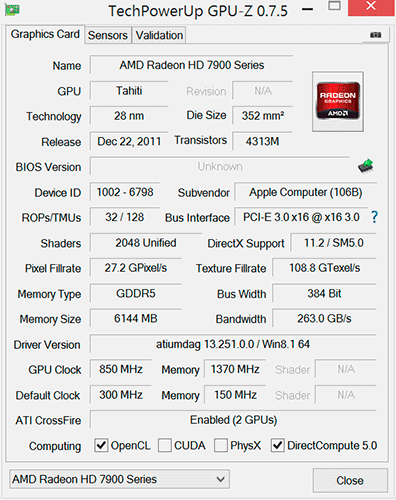
The model numbers are unique to Apple. FirePro D300, D500 and D700 are the only three options available on the new Mac Pro. The D300 is Pitcairn based, D500 appears to use a Tahiti LE with a wider 384-bit memory bus while D700 is a full blown Tahiti XT. I’ve tossed the specs into the table below:
| Mac Pro (Late 2013) GPU Options | ||||||
| AMD FirePro D300 | AMD FirePro D500 | AMD FirePro D700 | ||||
| SPs | 1280 | 1536 | 2048 | |||
| GPU Clock (base) | 800MHz | 650MHz | 650MHz | |||
| GPU Clock (boost) | 850MHz | 725MHz | 850MHz | |||
| Single Precision GFLOPS | 2176 GFLOPS | 2227 GFLOPS | 3481 GFLOPS | |||
| Double Precision GFLOPS | 136 GFLOPS | 556.8 GFLOPS | 870.4 GFLOPS | |||
| Texture Units | 80 | 96 | 128 | |||
| ROPs | 32 | 32 | 32 | |||
| Transistor Count | 2.8 Billion | 4.3 Billion | 4.3 Billion | |||
| Memory Interface | 256-bit GDDR5 | 384-bit GDDR5 | 384-bit GDDR5 | |||
| Memory Datarate | 5080MHz | 5080MHz | 5480MHz | |||
| Peak GPU Memory Bandwidth | 160 GB/s | 240 GB/s | 264 GB/s | |||
| GPU Memory | 2GB | 3GB | 6GB | |||
| Apple Upgrade Cost (Base Config) | - | +$400 | +$1000 | |||
| Apple Upgrade Cost (High End Config) | - | - | +$600 | |||
Despite the FirePro brand, these GPUs have at least some features in common with their desktop Radeon counterparts. FirePro GPUs ship with ECC memory, however in the case of the FirePro D300/D500/D700, ECC isn’t enabled on the GPU memories. Similarly, CrossFire X isn’t supported by FirePro (instead you get CrossFire Pro) but in the case of the Dx00 cards you do get CrossFire X support under Windows.
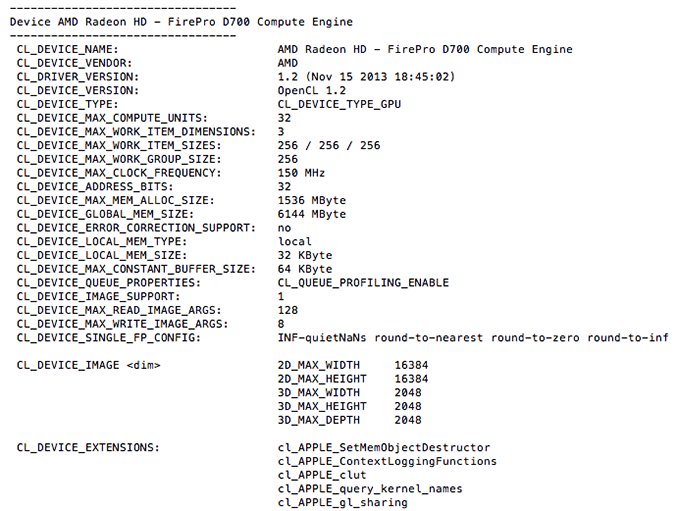
Each GPU gets a full PCIe 3.0 x16 interface to the Xeon CPU via a custom high density connector and flex cable on the bottom of each GPU card in the Mac Pro. I believe Apple also integrated CrossFire X bridge support over this cable.
With two GPUs standard in every Mac Pro configuration, there’s obviously OS support for the configuration. Under Windows, that amounts to basic CrossFire X support. Apple’s Boot Camp drivers ship with CFX support, and you can download the latest Catalyst drivers directly from AMD and enable CFX under Windows as well. I did the latter and found that despite the option being there I couldn’t actually disable CrossFire X under Windows. Disabling CFX would drop power consumption, but I didn't always see a corresponding decrease in performance.
Under OS X the situation is a bit more complicated. There is no system-wide CrossFire X equivalent that will automatically split up rendering tasks across both GPUs. By default, one GPU is setup for display duties while the other is used exclusively for GPU compute workloads. GPUs are notoriously bad at context switching, which can severely limit compute performance if the GPU also has to deal with the rendering workloads associated with display in a modern OS. NVIDIA sought to address a similar problem with their Maximus technology, combining Quadro and Tesla cards into a single system for display and compute.
Due to the nature of the default GPU division under OS X, all games by default will only use a single GPU. It is up to the game developer to recognize and split rendering across both GPUs, which no one is doing at present. Unfortunately firing up two instances of a 3D workload won’t load balance across the two GPUs by default. I ran Unigine Heaven and Valley benchmarks in parallel, unfortunately both were scheduled on the display GPU leaving the compute GPU completely idle.
The same is true for professional applications. By default you will see only one GPU used for compute workloads. Just like the gaming example however, applications may be written to spread compute workloads out across both GPUs if they need the horsepower. The latest update to Final Cut Pro (10.1) is one example of an app that has been specifically written to take advantage of both GPUs in compute tasks.
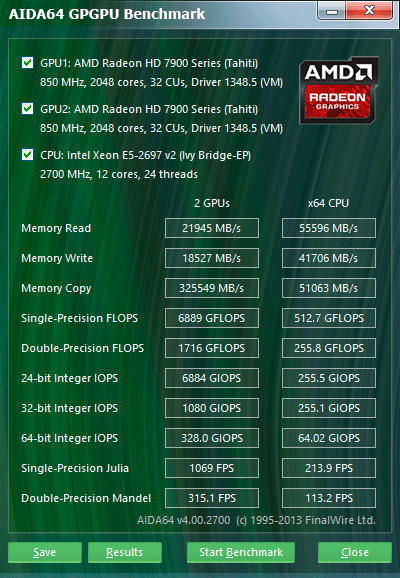
The question of which GPU to choose is a difficult one. There are substantial differences in performance between all of the options. The D700 for example offers 75% more single precision compute than the D300 and 56% more than the D500. All of the GPUs have the same number of render backends however, so all of them should be equally capable of driving a 4K display. In many professional apps, the bigger driver for the higher end GPU options will likely be the larger VRAM configurations.
![]()
I was particularly surprised by how much video memory Final Cut Pro appeared to take up on the primary (non-compute) GPU. I measured over 3GB of video memory usage while on a 1080p display, editing 4K content. The D700 is the only configuration Apple offers with more than 3GB of video memory. I’m not exactly sure how the experience would degrade if you had less, but throwing more VRAM at the problem doesn’t seem to be a bad idea. The compute GPU’s memory usage is very limited (obviously) until the GPU is actually in use. OS X reported ~8GB of usage when idle, which I can only assume is a bug and a backwards way of saying that none of the memory was in use. Under a GPU compute load (effects rendering in FCP), I saw around 2GB of memory usage on the compute GPU.
Since Final Cut Pro 10.1 appears to be a flagship app for the Mac Pro’s CPU + GPU configuration, I did some poking around to see how the three separate processors are used in the application. Basic rendering still happens on the CPU. With 4K content and the right effects I see 20 - 21 threads in use, maxing out nearly all available cores and threads. I still believe the 8-core version may be a slightly better choice if you're concerned about cost, but that's a guess on my part since I don't have a ton of 4K FCP 10.1 projects to profile. The obvious benefit to the 12-core version is you get more performance when the workload allows it, and when it doesn't you get a more responsive system.
Live preview of content that has yet to be rendered is also CPU bound. I don’t see substantial GPU compute use here, and the same is actually true for the CPU. Scrubbing through and playing back non-rendered content seems to use between 1 - 3 CPU cores. Even if you apply video effects to the project, prior to rendering this ends up being a predominantly CPU workload with the non-compute (display) GPU spending some cycles.
It’s when you actually go to render visual effects that the compute GPU kicks in. Video rendering/transcoding, as I mentioned earlier, is still a CPU bound affair but all effects rendering takes place on the GPUs. The GPU workload increases depending on the number of effects layered upon one another. Effects rendering appears to be spread over both GPUs, with the compute GPU taking the brunt of the workload in some cases and in others the two appear more balanced.
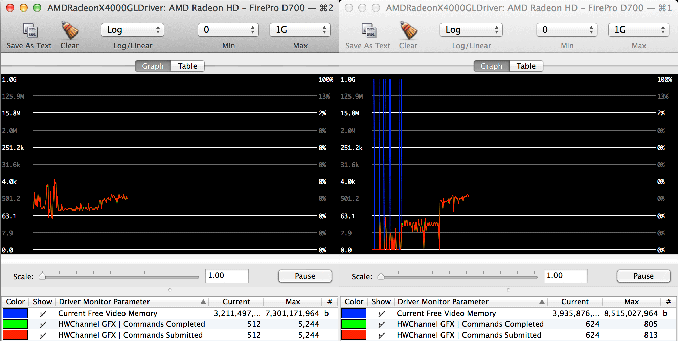
GPU load while running my 4K CPU+GPU FCP 10.1 workload
Final Cut Pro’s division of labor between CPU and GPUs exemplifies what you’ll need to see happen across the board if you want big performance gains going forward. If you’re not bound by storage performance and want more than double digit increases in performance, your applications will have to take advantage of GPU computing to get significant speedups. There are some exceptions (e.g. leveraging AVX hardware in the CPU cores), but for the most part this heterogeneous approach is what needs to happen. What we’ve seen from FCP shows us that the solution won’t come in the form of CPU performance no longer mattering and GPU performance being all we care about. A huge portion of my workflow in Final Cut Pro is still CPU bound, the GPU is used to accelerate certain components within the application. You need the best of both to build good, high performance systems going forward.


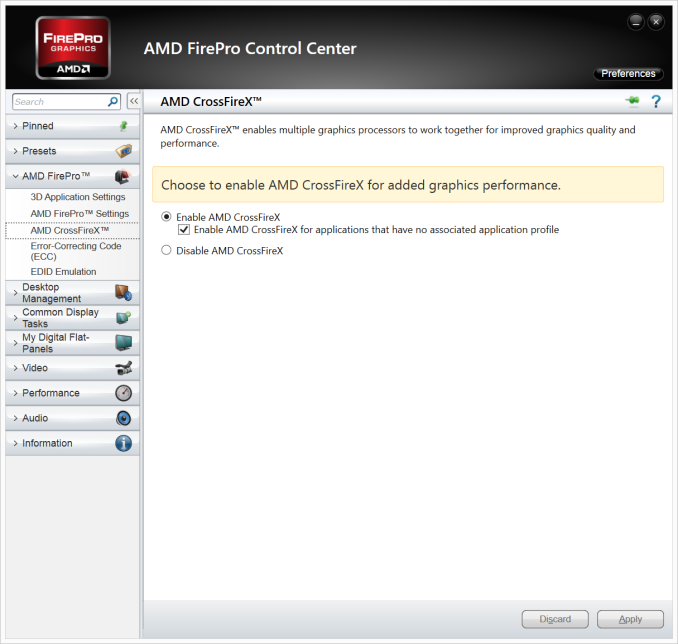
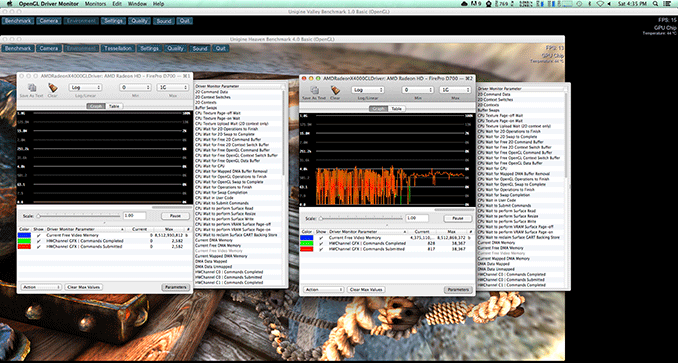








267 Comments
View All Comments
stevesup - Wednesday, January 1, 2014 - link
Great review, per usual. Even Leo Laporte couldn't dig out a negative nugget to bash Apple with.milkod2001 - Wednesday, January 1, 2014 - link
In a few months a market will probably be flooded with similar cases. Something like semitransparent case in this shape with decent led lighting could actually look quite nice.Back in Windows Vista times I was working with Mac Pro and iMac as graphic designer. It was a pleasure to work with compared to crappy, slow Vista based Pc.
Now with w7 I can't think about single reason I'd want to spend almost twice for Mac Pro compared to W7 Pc(obviously nobody is forcing me to).
Good job with review Anald.
milkod2001 - Wednesday, January 1, 2014 - link
sorry about misspelled name, can't find edit option for postMat9912 - Wednesday, January 1, 2014 - link
Can someone comment on the power consumption of the new Mac Pro when in standby/sleep mode?knweiss - Thursday, January 2, 2014 - link
You'll find the info in the Mac Pro Environmental Report:http://images.apple.com/environment/reports/docs/M...
nomorespam - Wednesday, January 1, 2014 - link
Any idea why the three networking ports couldn't have been combined into a single PCIe 2.0 lane with a switch/bridge?By my math this comes to at most 3.3Gbps (412MB/s) unidirectional with all three ports saturated.
Is this not a possibility or are there other considerations that make this impractical or undesirable?
I'm thinking it would be really nice to get another 2 (ideally 3 for no bottleneck) of the PCIe 2.0 lanes to the USB 3.0 ports and this seems like a valid way to triple available USB 3.0 bandwidth.
The only other place I can see to steal an additional PCIe 2.0 lane back to get to 4 port bottleneck free USB 3.0 I/O is to take one lane away from the SSD controller?
Surely doing so reduces the bus width and resulting net performance even though the theoretical 1.5GB/s that three PCIe 2.0 lanes provide is still faster than the Mac Pro's shipping SSD's?
Like Neil above, I would also like to know more about IP over thunderbolt 1 and 2 and how it works in the real world today - I would suspect the network stack is not in any way optimized for it at this point.
OreoCookie - Wednesday, January 1, 2014 - link
@AnandAny reason why you haven't posted results on your SSD consistency tests for the Mac Pro?
wozwoz - Wednesday, January 1, 2014 - link
Nice review - though rather too long. Sometimes, less is more :)Unfortunately, what is not answered, and remains 'unknown' is:
* Is a D500 graphics card actually any faster than a D300 in real-world tests? [Note that the D500 has a lower clock speed]
* Since the D700 apparently consumes vastly more power than the D300, how does the graphics card effect noise levels and thermal performance of the entire machine?
I liked your chart of CPU turbo boost, as the number of cores in play changes ... first decent explanation of that issue.
bizarrefish - Wednesday, January 1, 2014 - link
Excellent review Anand, very comprehensive and just what I needed to help seal the decision to buy. I believe some of your benchmarks and stress testing was under Boot Camp Windows correct? I too want to use the system as my main Workstation/PC at home but for occasional gaming also. The system will spend most of its time in OSX but Is the driver support good enough to perform well in Boot Camp for modern gaming needs? Thanks.jackbobevolved - Saturday, April 19, 2014 - link
I got the 12 core D700 model and it works great for gaming. The latest Catalyst drivers installed without issue and performance has been amazing. What really blew me away though was comparing the render and export speed on this machine against my old 3,1 8 core with a Radeon 5870. Several hour exports from FCPX were cut to just minutes.